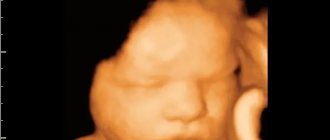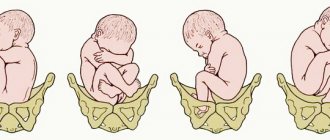Planning a new pregnancy
The question of the ideal age difference between the first and second child worries many mothers who dream of adding to their family. Should you quickly give birth to a brother or sister for your child, so that the children can have fun with each other? Should I wait and pay more attention to my older child before the baby arrives? The answer will be different for each family, because many different factors need to be taken into account: the career plans of both parents, financial situation, health. In addition, all options have their pros and cons.
The difference is 1 – 2 years
pros
- When the children get a little older, they will be interested in playing together, they will probably have joint activities and company;
- By the time your second child is born, you have already gained experience and have not forgotten anything - caring for a baby will not cause any difficulties;
- If you are taking a career break to care for your children, you can combine two maternity leaves;
- Things left over from an older child will not lose their relevance;
- Psychologists equate the same age with twins: they don’t remember life without each other, and the older one is too young to be seriously jealous. Children with such an age difference are usually very close.
Minuses
- The mother’s body does not have time to recover from the previous pregnancy and breastfeeding. According to one of the best clinics in the United States, the Mayo Clinic, if less than 18 months pass between childbirth and the onset of the next pregnancy, the likelihood of certain medical problems increases;
- The first few years will not be easy for you, because by the time the baby arrives, the eldest will still not be independent. During pregnancy, you will be forced to lift him often, and after childbirth, you will have to change the diapers of two people at once, dress them and feed them;
- The older child is not yet psychologically ready to move away from his mother, and you will no longer be able to pay enough attention to him.
Features of repeat pregnancy
Signs of a second birth sometimes differ significantly from those familiar to a woman from her first experience. The key factor is fear. Fear of a second birth is present, despite the woman’s confidence in a positive outcome.
How does the second birth begin? A few days before giving birth, a pregnant woman’s stomach drops, it becomes easier for her to breathe, and she is not bothered by shortness of breath or heartburn. However, sleep may worsen and it becomes more difficult for her to find a comfortable position.
If the second birth is coming and the plug has come out, it means that the mother’s body is ready and in a few days the baby will be born. The plug refers to the discharge that forms in the first weeks of pregnancy. Thickening and thickening, they close the entrance to the cervix.
Contractions during the second birth last from 5 to 9 hours. If they turn into attempts (harbingers of the second birth) in less than six hours, then the baby will not wait long.
Signs of contractions - they are distinguished by regularity, frequency and decreasing intervals between them. The child's behavior also changes. A few days before giving birth, its activity decreases. Only “lazy” signals remain. But right before the birth process begins, activity increases sharply so that the mother knows “it’s time.”
When giving birth to a second child, a woman’s body remembers previous experiences. How exactly the birth will take place depends on the presence of chronic diseases, complications after the birth of the first child, and the time that has passed since that moment.
The difference is 3 – 4 years
pros
- The body has time to recover before a new pregnancy;
- If you went back to work after your first birth, you probably created a financial “safety cushion” that will be very useful during your second pregnancy;
- If you decide to fully use your legal leave to care for a child (up to 3 years), you will have time to move from maternity leave to maternity leave;
- The older child has already grown up and requires a little less care. If he goes to kindergarten, you will have enough time for the baby.
Minuses
- Psychologists warn that during a crisis of 3 years, it is difficult for a child to adapt to the appearance of a younger child in the family: one stress is superimposed on another;
- If the older child has just started attending kindergarten, he will have to get used to an unfamiliar team and a new family member at the same time, and this is difficult. In addition, he will probably “bring” diseases to the baby from the garden;
- The eldest child is still very small, he needs the full attention of adults;
- The first-born remembers life well without the youngest and understands that it was the newborn who changed the established way of life. He will probably be jealous of the baby.
UZ "Mogilev City Emergency Hospital"
The second stage of labor is the period of expulsion. It begins after the cervix is fully dilated and ends with the birth of the baby. The duration of the expulsion period for primiparous women is 1-2 hours, for multiparous women – 15-30 minutes. Here, in addition to strong contractions, contractions of the muscles of the abdominal wall, diaphragm and pelvic floor, and a feeling of pressure on the rectum are added - this condition is called pushing.
During the expulsion period, the woman in labor is in the delivery room on a special bed, in a supine position with her legs bent at the hip and knee joints. The head end of the bed is raised. In a semi-sitting position, the axis of the uterus and the axis of the small pelvis coincide, which improves the advancement of the head along the birth canal. At the moment of pushing, in order to strengthen it, the woman in labor holds the bed with her hands and rests her feet on the stand. It is necessary to prepare a sterile package for the initial treatment of a newborn and a set of sterile linen - a blanket and 3 diapers, heated to 40*C. The pubis, inner thighs, external genitalia, and perineum are treated.
The average duration of each push is 10–15 seconds. Usually during one contraction a woman feels the need to push an average of three times . And although contractions are the strongest at this point, most women say that when pushing joined the contractions, they became less painful. Pushing, unlike contractions, can be controlled - a woman can delay pushing or, conversely, intensify it. If the doctor or midwife still prohibits pushing, then the “doggy style” breathing technique will help to restrain the efforts. Usually the midwife says: “Don’t push, just breathe!” Then you need to breathe shallowly with short inhalations and exhalations.
How to push correctly? When starting to push, you should always listen to your doctor or midwife. If the midwife says: “Push!”, you need to:
- At the moment when it is time to push, the woman in labor needs to take in full lungs of air, inhaling through her mouth and holding her breath, as before immersing herself in water, while keeping her shoulders down. You need to exhale very smoothly through a slightly open mouth. This is how you need to act until the end of the attempt. The most important thing is the pushing movement and all the woman’s efforts should be directed towards the perineum.
- During each contraction you need to push three times.
3. You need to push smoothly, and between pushes you need to rest and prepare yourself for work.
Attempts are the main moment of childbirth; the outcome of the birth and the condition of the child depend on them. Therefore, even if you no longer have the strength, you need to gather your will into a fist and start pushing. It is very important to take deep, calm breaths between contractions. This will allow you to gain strength before the next contraction and effectively carry out the next push. In between attempts, the doctor will listen to the baby's heartbeat with a CTG sensor or an obstetric stethoscope. Pushing is hard and painful, but this is very important for the baby: at this moment it is also difficult for him, and only the mother can help.
If during pushing there is a possibility of a rupture of the perineum, then the doctor makes an incision - an episiotomy. As soon as the fetal head stops hiding in the pelvis, the midwife takes the newborn baby into the world.
Immediately after the head appears, it clears the baby's airways and he cries for the first time. The baby is laid on the mother's stomach, the baby takes his first breath and lights up the delivery room with a long-awaited cry. At the same time, the midwife dries the baby's wet skin with a warm diaper, then the umbilical cord is cut, and the pediatrician assesses the baby's condition using the Apgar scale. The baby is handed over to the mother and applied to the breast. This way he warms up and adapts to the environment, and the mother’s body begins to produce oxytocin, which triggers the process of milk formation and causes postpartum contractions of the uterus. It is in skin-to-skin contact with his mother that his acquaintance with the world begins. At this time, an invisible psycho-emotional connection arises between mother and child, which in the future will become the basis for the formation of attachment between them. The first 20 minutes after birth are a period of relaxation for the baby. During this period, he regains strength after hard work. After 20 minutes, the next phase begins - awakening. The baby begins to move, turns his head, unclenches his fists and tries to crawl. With the beginning of physical activity, the baby comes to the first feeling of hunger. It is very important that the baby finds and takes the breast at the moment the search reflex appears. The baby begins to open his mouth, clench and unclench his palms, then he begins to crawl, raising his head and pushing off with his legs and elbows, towards his mother’s chest.
In the second stage of labor - pushing and expulsion of the fetus, the role of the partner is moral support: you can simply hold the woman in labor, wipe the sweat from her forehead and help her breathe correctly (at the doctor’s command).
For the father of a child, a partner birth is an opportunity to help his beloved woman during childbirth, see how the child is born and hold him in his arms. This is how unbreakable bonds are formed between all family members.
The difference is 5 – 7 years
pros
- According to perinatal psychologists, 5 years is the optimal age difference between children. The eldest has already experienced a crisis of 3 years, and perhaps also adaptation in kindergarten, and it will be easier for him to get used to new changes in life;
- Over the years, your health has completely recovered;
- The older child understands everything well and will even be able to help you and the baby in some way;
- Children will be interested in different activities and toys, and the number of conflicts will decrease.
Minuses
- For 5 - 7 years, you have probably forgotten what it is like to be the mother of a baby, you have lost the habit of staying up at night and completely devoting yourself to a helpless baby;
- If you have just resumed your career after the first maternity leave, you will have to give it up again - this can become a painful moment;
- Children's routines and interests will vary greatly. Over the course of several years, you will have to take them to different clubs and events, and put them to bed at different times.
8 years difference or more
pros
- The eldest child is already quite an adult: he knows how to dress himself, get ready for school and even cook breakfast. In the first weeks you will be able to pay maximum attention to your youngest;
- If for some reason you stay late in the maternity hospital, the eldest will calmly stay with dad or grandmothers;
- A child over 8 years old is quite capable of helping you with the baby - within reason, of course;
- Psychologists suggest that children with a difference of more than 7 years should be perceived as “the only two.” Their interests and needs are so different that they definitely won’t take each other’s toys and share space.
Minuses
- Over the years, not only the first-born has grown - the mother has become much older, pregnancy and childbirth can be difficult for her;
- Due to the large age difference, it will not be easy to organize family leisure time that is interesting for both children;
- You will actually have to re-learn the science of caring for a baby: new trends in pediatrics, strange children's products and gadgets have appeared.
Be that as it may, remember that it is impossible to plan everything. Even if you had your first child very quickly, there is no guarantee that the next pregnancy will come as easily. Conversely, if you dreamed of children with a large age difference, a new baby may unexpectedly come into your family much earlier.
If your first baby was born by caesarean section, planning your next pregnancy should be taken seriously. The body needs to recover after the operation: the interval between births should be at least 2 years. Before planning, it is worth conducting an ultrasound examination of the seam to check its condition.
Another important issue is the choice of method of delivery. The principle “after cesarean, only cesarean” is a thing of the past, and the expectant mother may well try to give birth on her own. It all depends on the state of her health, the course of pregnancy, the strength of the scar, the weight and presentation of the child - and, of course, desire: it is psychologically difficult for many mothers to decide on a natural birth after a cesarean.
What should you be prepared for during your second pregnancy?
- Every pregnancy is unique, and you will have to experience this for yourself. However, some problems tend to recur: for example, toxicosis, edema, high blood pressure, miscarriage;
- Even if during your first pregnancy you had a flat stomach until the 6th month, don’t count on it the second time. The uterus, ligaments and muscles are already stretched, and everyone will guess about your position quite quickly;
- You will probably feel the baby's movements earlier than the first time - most likely, already at 16 - 18 weeks;
- During the second pregnancy, the belly drops much faster. You may need to wear a brace to reduce the strain on your back;
- Many women experience problems with blood vessels during their second pregnancy. If you feel heaviness in your legs, and noticeable “nets” appear on your skin, consult your doctor - you may need compression stockings;
- It is popularly believed that the first pregnancy usually lasts longer than 40 weeks, and the second - less. This is not so: according to statistics, the first and subsequent births, as a rule, occur at approximately the same time;
- If the mother has a negative Rh factor, the likelihood of Rh conflict increases with each pregnancy. In this case, careful medical supervision and constant monitoring of the amount of antibodies in the blood is necessary;
- During a second pregnancy, the risk of iron deficiency anemia increases. Its symptoms are headache, fatigue, memory impairment. The baby also suffers from a lack of hemoglobin, so do not forget to take special medications as prescribed by the doctor;
- The second child is usually larger than the first and weighs 200 - 500 g more. This is explained by the fact that the “experienced” mother’s body transfers more useful substances to him, and the uterus is enlarged after the first birth;
- The second birth, as a rule, is much faster and more intense. The cervix softens and dilates at the same time, which is quite painful, but this speeds up the process.
How long does the second birth last?
Doctors say that the second birth is faster and easier. The birth of the first child takes on average 11-12 hours, the second - only 7-8. During the second birth, the time is reduced at all stages: during repeated births, the cervix is softer, more elastic, stretches more easily, which means it will open earlier, because during repeated births it both contracts and opens at the same time; the second stage - pushing - is much more energetic, since the body “remembers” the previous birth and easily enters the phase of expulsion of the fetus. A multiparous woman breathes and strains more competently, and can “push out” the baby in just a few minutes.
At the same time, doctors state: every birth is unique and individual, no matter what kind of birth it is. The mothers themselves agree with this opinion: many of them gave birth much longer the second time than the first. Therefore, each birth is treated with full responsibility, carefully prepared and, naturally, worried.











